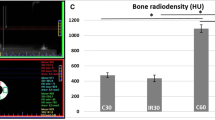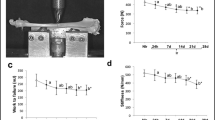Abstract
Ionizing radiation, from both space and radiation therapy, is known to affect bone health. While there have been studies investigating changes in bone density and microstructure from radiation exposure, the effects of radiation on material properties are unknown. The current study addresses this gap by assessing bone material property changes in rats exposed to helium-4 radiation through spherical micro-indentation. Rats were exposed to a single dose of 0, 5, and 25 cGy whole body helium-4 radiation. Animals were euthanized at 7, 30, 90, or 180-days after exposure. Spherical micro-indentation was performed on axial cross sections of the femur cortical bone to determine instantaneous and relaxed shear moduli. At 90-days after exposure, the 25 cGy exposure caused a significant decline in shear modulus compared to control and 5 cGy groups. The instantaneous modulus decreased 33% and the relaxed modulus decreased 32% as compared to the sham group. This decline was followed by a recovery of both moduli, which was observed by 180-days after exposure; at 180 days, the moduli were no longer statistically different from those at 7 or 30 days. The observed decrease at 90 days, followed by recovery to baseline levels, can be attributed to the biological mechanisms involved in bone formation that were affected by radiation, bone turnover, and systemic changes in hormones due to radiation exposure. Continued assessment of the mechanisms that drive such a response in material properties may enable identification of pathways for therapeutic countermeasures against radiation exposure.







Similar content being viewed by others
Data Availability
Data will be made available upon request following the publication of manuscript.
References
Avery GB (1961) The biological effects of ionizing radiation. Clin Proc Child Hosp Dist Columbia 17:146–150
Willey JS, Lloyd SAJ, Nelson GA, Bateman TA (2011) Space Radiation and Bone Loss. Gravit Space Biol Bull 25:14–21
Hopewell JW (2003) Radiation-therapy effects on bone density. Med Pediatr Oncol 41:208–211. https://doi.org/10.1002/mpo.10338
Johnson D, Lawrence SE, Livingston EW et al (2018) Modeling Space Radiation Induced Bone Changes in Rat Femurs through Finite Element Analysis. Proc Annu Int Conf IEEE Eng Med Biol Soc EMBS 2018:1763–1766. https://doi.org/10.1109/EMBC.2018.8512620
Lloyd SAJ, Bandstra ER, Travis ND et al (2008) Spaceflight-relevant types of ionizing radiation and cortical bone: Potential LET effect? Adv Sp Res 42:1889–1897. https://doi.org/10.1016/j.asr.2008.08.006
Saunders WM, Char DH, Quivey JM et al (1985) Precision, high dose radiotherapy: helium ion treatment of uveal melanoma. Int J Radiat Oncol Biol Phys 11:227–233. https://doi.org/10.1016/0360-3016(85)90143-9
UNSCEAR (1982) Ionizing radiation sources and biological effects1982 Report to the General Assembly with annexes. United Nations, New York, pp 1–43
Townsend LW, Fry RJM (2002) Radiation protection guidance for activities in low-Earth orbit. Adv Sp Res 30:957–963. https://doi.org/10.1016/S0273-1177(02)00160-6
Willey JS, Lloyd SAJ, Nelson GA, Bateman TA (2011) Ionizing radiation and bone loss: Space exploration and clinical therapy applications. Clin Rev Bone Miner Metab 9:54–62. https://doi.org/10.1007/s12018-011-9092-8
Tessonnier T, Mairani A, Chen W et al (2018) Proton and Helium Ion Radiotherapy for Meningioma Tumors: A Monte Carlo-based Treatment Planning Comparison. Radiat Oncol 13:1–10. https://doi.org/10.1186/s13014-017-0944-3
Simonetto C, Rennau H, Remmele J et al (2019) Exposure of remote organs and associated cancer risks from tangential and multi-field breast cancer radiotherapy. Strahlentherapie und Onkol 195:32–42. https://doi.org/10.1007/s00066-018-1384-1
Lloyd SA, Bandstra ER, Willey JS et al (2012) Effect of proton irradiation followed by hindlimb unloading on bone in mature mice: A model of long-duration spaceflight. Bone 51:756–764. https://doi.org/10.1016/j.bone.2012.07.001
Wernle JD, Damron TA, Allen MJ, Mann KA (2010) Local irradiation alters bone morphology and increases bone fragility in a mouse model. J Biomech 43:2738–2746. https://doi.org/10.1016/j.jbiomech.2010.06.017
Chauhan S, Khan SA, Prasad A (2018) Irradiation-Induced Compositional Effects on Human Bone After Extracorporeal Therapy for Bone Sarcoma. Calcif Tissue Int. https://doi.org/10.1007/s00223-018-0408-2
Pharr G, Oliver W, Brotzen F (1992) On the generality of the relationship among contact stiffness, contact area, and elastic modulus during indentation. J Mater Res 7:613–617
Mattice JM, Lau AG, Oyen ML, Kent RW (2006) Spherical indentation load-relaxation of soft biological tissues. J Mater Res 21:2003–2010. https://doi.org/10.1557/jmr.2006.0243
Lau A, Oyen ML, Kent RW et al (2008) Indentation stiffness of aging human costal cartilage. Acta Biomater 4:97–103
Alwood JS, Tran LH, Schreurs AS et al (2017) Dose- and ion-dependent effects in the oxidative stress response to space-like radiation exposure in the skeletal system. Int J Mol Sci 18:1–17. https://doi.org/10.3390/ijms18102117
Zhai J, He F, Wang J et al (2019) Influence of radiation exposure pattern on the bone injury and osteoclastogenesis in a rat model. Int J Mol Med 44:2265–2275. https://doi.org/10.3892/ijmm.2019.4369
Mcevoy MD, Sabbagh MJ, Taylor AG et al (2010) Single-Limb Irradiation Induces Local and Systemic Bone Loss in a Murine Model. J Bone Miner Res 108:399–406. https://doi.org/10.1002/jbmr.2458.Single-Limb
Sadhukhan R, Leung JWC, Garg S et al (2020) Fractionated radiation suppresses Kruppel-like factor 2 pathway to a greater extent than by single exposure to the same total dose. Sci Rep 10:1–13. https://doi.org/10.1038/s41598-020-64672-3
Maes C, Kobayashi T, Selig MK et al (2010) Osteoblast Precursors, but not Mature Osteoblasts, Move into Developing and Fractured Bones along with Invading Blood Vessels. Dev Cell 19:329–344. https://doi.org/10.1038/jid.2014.371
Pittenger MF, Discher DE, Péault BM et al (2019) Mesenchymal stem cell perspective: cell biology to clinical progress. npj Regen Med. https://doi.org/10.1038/s41536-019-0083-6
Heo JS, Choi Y, Kim HS, Kim HO (2016) Comparison of molecular profiles of human mesenchymal stem cells derived from bone marrow, umbilical cord blood, placenta and adipose tissue. Int J Mol Med 37:115–125. https://doi.org/10.3892/ijmm.2015.2413
Sawajiri M, Mizoe J, Tanimoto K (2003) Changes in osteoclasts after irradiation with carbon ion particles. Radiat Environ Biophys 42:219–223. https://doi.org/10.1007/s00411-003-0204-9
Margulies B, Morgan H, Allen M et al (2003) Transiently Increased Bone Density After Irradiation and the Radioprotectant Drug Amifostine in a Rat Model. Am J Clincial Oncol 26:3106-e114
Aboelnaga MM, Aboelnaga EM (2015) Early parathyroid hormone laboratory abnormalities related to therapeutic radiation of neck: An Egyptian experience. Med Oncol 32:1–5. https://doi.org/10.1007/s12032-015-0620-0
Lelovas PP, Xanthos TT, Thorma SE et al (2008) The laboratory rat as an animal model for osteoporosis research. Comp Med 58:424–430
Boehm BO, Rosinger S, Belyi D, Dietrich JW (2011) The parathyroid as a target for radiation damage. N Engl J Med 365:676–678. https://doi.org/10.1056/NEJMc1104982
Arias CF, Herrero MA, Echeverri LF et al (2018) Bone remodeling: A tissue-level process emerging from cell-level molecular algorithms. PLoS ONE. https://doi.org/10.1371/journal.pone.0204171
Manolagas SC (2000) Birth and death of bone cells: Basic regulatory mechanisms and implications for the pathogenesis and treatment of osteoporosis. Endocr Rev 21:115–137. https://doi.org/10.1210/er.21.2.115
Sengupta P (2013) The Laboratory Rat: Relating Its Age With Human’s. Int J Prev Med 4:624–630
Netto CC, Vieira VCC, Marinheiro LPF et al (2012) Are skeletally mature female rats a suitable model to study osteoporosis? Arq Bras Endocrinol Metabol 56:259–264. https://doi.org/10.1590/S0004-27302012000400007
Makowska J, Lewandowska-Polak A, Kowalski ML (2015) Hypersensitivity to Aspirin and other NSAIDs: Diagnostic Approach in Patients with Chronic Rhinosinusitis. Curr Allergy Asthma Rep 15:1–11. https://doi.org/10.1007/s11882-015-0552-y
Davis CM, Decicco-Skinner KL, Roma PG, Hienz RD (2014) Individual differences in attentional deficits and dopaminergic protein levels following exposure to proton radiation. Radiat Res 181:258–271. https://doi.org/10.1667/RR13359.1
Bach-Gansmo FL, Weaver JC, Jensen MH et al (2015) Osteocyte lacunar properties in rat cortical bone: Differences between lamellar and central bone. J Struct Biol 191:59–67. https://doi.org/10.1016/j.jsb.2015.05.005
Duranova H, Martiniakova M, Omelka R et al (2014) Changes in compact bone microstructure of rats subchronically exposed to cadmium. Acta Vet Scand 56:64. https://doi.org/10.1186/s13028-014-0064-0
Acknowledgements
We would like to thank Rosalie Connell, Calvin Okulicz, and Gilberto Torres for experimental support. The opinions and assertions expressed herein are those of the author(s) and do not necessarily reflect the official policy or position of the Uniformed Services University or the Department of Defense.
Funding
This work was funded by the College of New Jersey Mentored Undergraduate Summer Experience program, the New Jersey Space Grant Consortium Research Fellowship, and NASA Grant 80NSSC18K1080.
Author information
Authors and Affiliations
Contributions
PT: Specimen Collection, Conducted Experiments, Collection and Analysis of Data, Statistical Analysis and Interpretation of Data, and Preparation of Manuscript. LS: Formulation of Experimental Protocol, Statistical Analysis and Interpretation of Data, and Preparation of Manuscript. GD: Formulation of Experimental Protocols, Statistical Analysis and Interpretation of Data, and Preparation of Manuscript. CD: Conducted Animal Experiment, Specimen Collection, Analysis and Interpretation of Data, Preparation of Manuscript, Conception of Study, and Co-Principle Investigator. AL: Specimen Collection, Development of Experimental Protocols, Conducted Experiments, Analysis and Interpretation of Data, Preparation of Manuscript, Conception of Study, and Principle Investigator.
Corresponding authors
Ethics declarations
Conflict of interest
Dr. Dickinson, Dr. Lau, and Dr. Sullivan have nothing to disclose. Dr. Davis reports grants from NASA, during the conduct of the study. Miss Thomas reports grants from New Jersey Space Grant Consortium, during the conduct of the study.
Human and Animal Rights
Laboratory animal care was conducted according to Public Health Service (PHS) Policy on the Humane Care and Use of Laboratory Animals, and the Institutional Animal Care and Use Committee of the Johns Hopkins University (RA17M78) approved all procedures. Johns Hopkins also maintains accreditation of their program by the Association for the Assessment and Accreditation of Laboratory Animal Care (AAALAC). Rats radiation exposures were also conducted under approved Animal Protocol at Brookhaven National Laboratory (BNL) (Protocol # 337). No live animal work was performed at The College of New Jersey.
Consent to Participate
N/A.
Consent for Publication
N/A.
Additional information
Publisher's Note
Springer Nature remains neutral with regard to jurisdictional claims in published maps and institutional affiliations.
Rights and permissions
About this article
Cite this article
Thomas, P.K., Sullivan, L.K., Dickinson, G.H. et al. The Effect of Helium Ion Radiation on the Material Properties of Bone. Calcif Tissue Int 108, 808–818 (2021). https://doi.org/10.1007/s00223-021-00806-7
Received:
Accepted:
Published:
Issue Date:
DOI: https://doi.org/10.1007/s00223-021-00806-7




